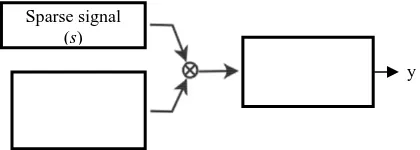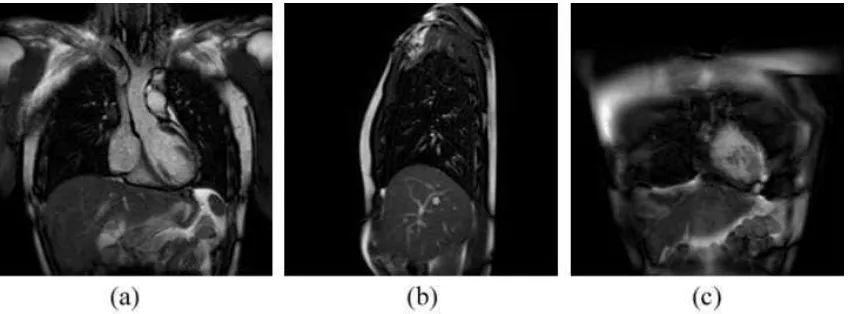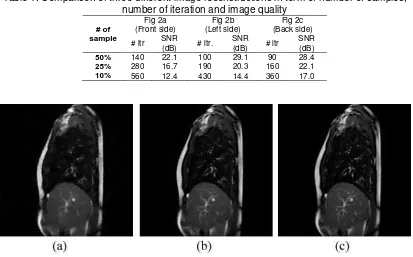ISSN: 1693-6930
accredited by DGHE (DIKTI), Decree No: 51/Dikti/Kep/2010 147
Compressed Sensing for Thoracic MRI with Partial
Random Circulant Matrices
Windra Swastika1, Hideaki Haneishi2 1
Informatics Engineering Study Program, Ma Chung University, Malang, Indonesia Villa Puncak Tidar N/01, Malang, Phone: +62-341-550171
2
Research Center for Frontier Medical Engineering, Chiba University, Chiba, Japan 1-33, Yayoi-cho, Inage-ku, Chiba 263-8522
e-mail: [email protected]
Abstrak
Penggunaan matriks sirkulan sebagai matriks pengindera pada skema penginderaan kompresif (CS) telah banyak digunakan untuk mengatasi keterbatasan matriks random atau Fourier parsial. Disamping mengurangi kompleksitas komputasi, penggunakan matriks sirkulan untuk citra magnetic resonance (MR) dapat mempermudah implementasi perangkat keras. Pada makalah ini dijabarkan tentang simulasi penginderaan kompresif untuk citra MR pada organ pernafasan menggunakan matriks sirkulan sebagai matriks pengindera. Rekonstruksi dari tiga jenis citra MR dibandingkan berdasarkan jumlah sample, jumlah iterasi, dan kualitas rekonstruksi menggunakan signal to noise ratio (SNR). Dari hasil simulasi menunjukkan bahwa matriks sirkulan dapat difungsikan dengan eifisien untuk merekonstruksi citra MR, khususnya untuk citra MR yang tipis pada kawasan spasial.
Kata kunci: penginderaan kompresif, citra MR, organ pernafasan, matriks circulant
Abstract
The use of circulant matrix as the sensing matrix in compressed sensing (CS) scheme has recently been proposed to overcome the limitation of random or partial Fourier matrices. Aside from reducing computational complexity, the use of circulant matrix for magnetic resonance (MR) image offers the feasibility in hardware implementations. This paper presents the simulation of compressed sensing for thoracic MR imaging with circulant matrix as the sensing matrix. The comparisons of reconstruction of three different type MR images using circulant matrix are investigated in term of number of samples, number of iteration and signal to noise ratio (SNR). The simulation results showed that circulant matrix works efficiently for encoding the MR image of respiratory organ, especially for smooth and sparse image in spatial domain.
Keywords: compressive sensing, MR image, respiratory organ, circulant matrix
1. Introduction
[6]. Clearly, the needs to reduce imaging time which yields high quality image is the holy grail in MR imaging technology.
Compressed Sensing (CS) is a relatively new method introduced by Donoho and Candes [2-3] and expected to answer one of the issue in MR image acquisition, fast imaging time acquisition without losing its quality. It is built upon the fact that a signal (image) has a sparse representation in a priori known basis (or compressible). A signal ū with length n can be transformed using an orthogonal basis Ψ (e.g. Fourier or Wavelet basis) such that Ψ.= ̅. recovery into a perfect recovery of . Another condition needs to be satisfied to reconstruct from y is restricted isometry property (RIP) of matrix Φ which is obeyed by many types of matrices (e.g Random Gaussian, Bernoulli, Partial Fourier Matrices) [7]. The reconstruction process can be done by greedy method (fast, but requires more measurements) or solving convex optimization problem (slow but requires less measurement data).
Lustig et al in [5] showed that MR image is suitable for CS implementation since it has sparse representation in certain transform domain. The DCT and Wavelet transform have good performance of recovering brain and angiogram MR images with 5-10% coefficients. Moreover, wavelet transform also proven to be effective for real-time data transmission for real image (JPEG2000) [13] showing that both medical and real image are actually sparse in when transformed into certain domain. But the success of reconstruction does not only merely depend on the sparse representation. Another factor is to satisfy RIP, which is a tool for analyzing the performance how efficient a matrix measures sparse signal [8]. Recent widely measurement matrices that satisfy RIP with high probability is independent and identically distributed (i.i.d) random Gaussian matrix. Although Gaussian matrix provides incoherence with any sparse signal and the number of measurements for signal recovery is minimal, it requires huge memory storage and high complexity computation. Using Gaussian matrix as sensing matrix to acquire a 256x256 image with 50% sampling will require nearly gigabyte space and giga-flop operation, leads to impractical application of CS scheme for MR device. Structurally random matrices, such as Toeplitz or Circulant matrix have been shown to be fast computable and satisfy RIP property as well for almost all orthonormal matrices [9]. But, the efficiency using Circulant matrix to reconstruct MR images have not been known.
In this paper, we investigated the efficiency of using circulant matrix as sensing matrix for MR Image of respiratory organ compared to partial Fourier matrix. The reconstruction is done via conventional l1-norm minimization.
The contents of this paper are organized as follows: in Section II we review the basic theory of compressed sensing and MR image of respiratory organ motion. In Section III, we discuss the methodology we use in the experiment and also the simulation results. We conclude this paper in Section IV.
2. Basic Theory
There are three stages in CS scheme: encoding, sensing and decoding (reconstruction). Encoding is a stage of sparsifying input signal (or image) using certain basis representation (such as Fourier or wavelet). Sensing phase is a process to measure the sparse signal representation and reducing its dimension using sensing matrix and at last, decoding is a process to reconstruct the sensing signal.
2.1. CS with Total Variation Minimization
The encoding phase starts with an input of 1-D discrete signal with length n that can be represented in term of an orthonormal basis {ψ}୧ୀଵ୬ as:
̅=∑ ψ୧
୬
୧ୀଵ ୧= ψ (1)
Vector ̅ is a sparse representation of vector and has k non-zeros coefficients. We say that vector ̅ is highly compressible if k << n, or in other word, non-zeros or significant coefficients much smaller than length of vector .
The sensing phase of CS needs measurement matrix for projecting vector ̅ into smaller dimension. Let is a measurements matrix with m x n dimension (where k < m << n), the linear projection of sparse vector ̅ is given by:
y
= Φ̅= Φψ= A (2)
The measurement matrix has to be independent of ̅ (non-adaptive/fixed). From (2) we have vector of measurements y with length m.
The decoding stage is a stage to reconstruct ̅ from y and matrix . Since there are m equation and n unknowns to be solved, the reconstruction becomes an ill-posed problem underdetermined system) with infinitely many solutions. CS theory [1, 2] states that vector ̅ can be recovered by solving convex problem. As long as is highly sparse, finding the sparsest solution will be the “best guest” to recover vector ̅.
min‖x‖ = (3)
Unfortunately, (3) is a NP-hard problem and computationally impractical. An effective way to recover ̅ is to solve ℓଵ-norm instead of ℓ-norm. This method is also known as Basis-pursuit.
min‖x‖ଵ = (4)
By solving ℓଵ-norm optimization problem, vector ̅ can be faithfully recovered. Another assumption in decoding phase is the number of measurements, ≥, for some small c where the measurements matrix is Gaussian or ≥ where the measurements matrix is random partial Fourier.
In practical application, MR image acquisition collects data in the frequency domain (k -space). Lustig et al in [4] proposed a reconstruction model for MR Image. Let be the undersampled Fourier transform, the reconstruction is given by:
min‖ψu‖ଵ subject to ‖ℱu− y‖ଶ< (5)
where represents as threshold parameter for noise level. Total Variation (TV) as the sum of the absolute variations in the image can be also employed. The reconstruction model in equation (5) can be written as:
min ‖ψu‖ଵ+ αu subject to ‖ℱu− y‖ଶ< (6)
Here, is a positive parameter. Better reconstruction in MR image from a small number of Fourier coefficients is achieved by additional TV.
2.2. Partial Random Circulant Matrix as Sensing Matrix
Fourier. Random matrices (such as Gaussian or Bernoulli random matrices) has optimal performance but requires big memory storage and complexity computation while partial Fourier enables a fast computation of Fast Fourier Transform (FFT) but lack of universality (only incoherence with sparse signal in time domain but not for smooth signal).
Circulant matrices are orthonormal matrices that are nearly incoherence with other orthonormal matrices [10], which provide universality with many types of signal. It is formed by starting with a vector with N components. The subsequent rows are acquired by shifting the partial circulant matrix which contains m number of rows.
A new paradigm of random filter was proposed by Tropp in [11] to captures signal s by convolution operation of random-tap FIR filter h, followed by subsampling. Figure 1 shows a block diagram of the measurement process through random filtering.
Figure 1.Block diagram of measurement process through random filtering
Using this paradigm, equation (2) can be written as:
y transformation. The theoretical analysis of restricted isometries for partial random circulant matrices is given by Rauhut et al in [10].
3. Results and Analysis
To demonstrate the effectiveness of partial random circulant matrix in MR image of respiratory organ, we used three models of MR images of respiratory organ from different patients. The MR images were acquired using a 1.5T Achieva Nova-Dual (Philips Medical Systems, Best, NL) whole-body scanner with a 16ch SENSE TORSO XL Coil. The size of each image is 256x256.
y Sparse signal
Experiments were performed under Windows 7 Professional running on Dell PC Desktop with an Intel® Core ™ 2 Quad CPU, 2.66GHz and 4GB RAM. The reconstruction model we used in the experiments is fast algorithm proposed in [12]. This algorithm is implemented in a MatLab program, RecPC [15]. Three original images are shown in Figure 2a, 2b, and 2c respectively. Each image represents different variation of respiratory organ. Figure 2a represents front side of respiratory organ, Figure 2b represents left side and Figure 2c represents back side.
Figure 2. Original MR images of respiratory organ. (a) Front side; (b) Left side; (c) Back side
The visual result of the reconstruction using partial random circulant matrix for image in Figure 2a, 2b and 2c are shown in Figure 3, 4 and 5 respectively. As shown in Figure 3, at the sample ratio of 10% and 25%, the reconstruction images still suffer from aliasing artifact due to the sharpness original image.
Figure 3. Result of image reconstruction, original image in Figure (2a) (a) 10% samples (12.4dB); (b) 25% samples (16.7dB); (c) 50% samples (22.1dB)
For reconstruction of Figure 2b and 2c (as shown in Figure 4, 5), the aliasing artifact are less at sample ratio of 25% and has better quality at sample ratio of 50% compared to Figure 3. The reconstruction works better for sparse and smooth image as in Figure 2b and 2c.
Table 1. Comparison of three different image reconstructions in term of number of samples, number of iteration and image quality
# of sample
Fig 2a (Front side)
Fig 2b (Left side)
Fig 2c (Back side)
# itr SNR
(dB) # itr.
SNR (dB) # itr
SNR (dB)
50% 140 22.1 100 29.1 90 28.4
25% 280 16.7 190 20.3 160 22.1
10% 560 12.4 430 14.4 360 17.0
Figure 4. Result of image reconstruction, original image in Figure (2b). (a) 10% sampling (14.4dB); (b) 25% sampling (20.3dB); (c) 50% sampling (29.1dB)
Figure 5. Result of image reconstruction, original image in Figure (2c). (a) 10% sampling (17.0dB); (b) 25% sampling (22.1dB); (c) 50% sampling (28.4dB)
As shown in [3], exact reconstruction of MR Images using CS scheme is achievable by employing random partial Fourier matrix. To validate our results, we compared the quality of MR Images reconstruction using circulant matrix and partial Fourier matrix. The number of sampling we picked for the comparison is 35%, 50% and 75%. This is due to the unstable reconstruction using random partial Fourier matrix when the number of sampling is below 35%. Table 2 shows the comparison of image reconstruction using circulant matrix (CM) and partial Fourier matrix (PFM) in term of SNR (dB).
reconstruction time was achieved by employing partial Fourier matrix, yet the reconstruction quality (SNR) is far below the circulant matrix.
Table 2.SNR (dB) comparison using Circulant Matrix (CM) and partial Fourier matrix (PFM)
# of
Table 3.Reconstruction time (sec) comparison using Circulant Matrix (CM) and partial Fourier matrix (PFM)
We applied CS using partial random circulant matrix as sensing matrix for MR image of respiratory organ. The comparison of three different MR image of respiratory organ using partial random circulant matrix as sensing matrix has been performed. It has been found that partial random circulant matrix can efficiently reconstruct MR image of respiratory organ especially for sparse image in spatial domain. As partial random circulant matrix has better image quality and faster reconstruction time when using lower sampling compared with partial Fourier matrix, its implementation for MR scanner is very promising. Further study can be carried out by combining the CS scheme using partial random circulant matrix with particular medical image techniques such as segmentation [14].
[3] E Candés, J Romberg, T Tao. Robust uncertainty principles: exact signal reconstruction from highly incomplete frequency information. Information Theory IEEE Transactions. 2006; 52(2): 489-509. [4] R Van de Walle, I Lemahieu, E Achten. Magnetic Resonance Imaging and the Reduction of Motion
Artifacts: Review of the Principles. Technology and Health Care. 1997; 5(6):419-435.
[5] M Lustig, D Donoho, JM Pauly. Sparse MRI: The application of compressed sensing for rapid MR imaging. Magn. Reson. Med. 2007; 58(6): 1182-1195.
[6] SKP Pruessmann. Encoding and reconstruction in parallel MRI. NMR in Biomedicine. 2006; 19(3): 288–299.
[7] E Candés, T Tao. Decoding by linear programming. IEEE Transaction on Information Theory. 2005; 51: 4203-4215.
[8] E Candés, JK Romberg, T Tao. Stable signal recovery from incomplete and inaccurate measurements. Comm. Pure Appl. Math. 2006; 59(8):1207–1223.
[9] TT Do, TD Tran, L Gan. Fast compressive sampling with structurally random matrices. Proc. IEEE Int. Conf. on Acoustics, Speech, and Signal Processing. 2008: 3369-3372.
[10] H Rauhut, J Romberg, J Tropp. Restricted isometries for partial random circulant matrices. Arxiv preprint. 2010; arXiv:1010.1847
[11] J Tropp, M Wakin, M Duarte, D Baron, R Baraniuk. Random filters for compressive sampling and reconstruction. Int. Conf. Acoustics, Speech, and Signal Processing. 2006; 3: 872–875.
[12] W Yin, SP Morgan, J Yang, Y Zhang. Practical compressive sensing with toeplitz and circulant matrices. 2010; Rice University CAAM Technical Report TR10-01.
[14] A Alfiansyah. A Unified Engergy Approach for B-Spline Snake in Medical Image Segmentation.
TELKOMNIKA. 2010; 8(2): 175-186.


